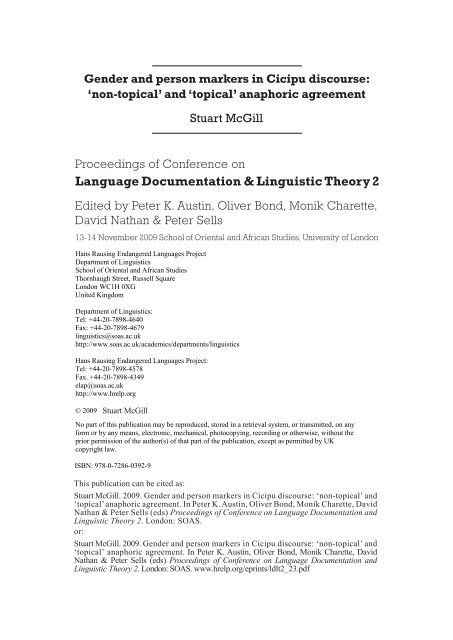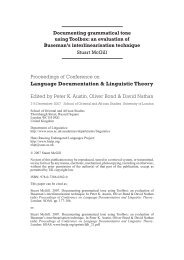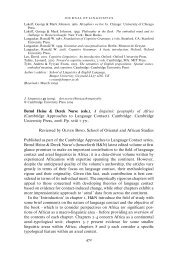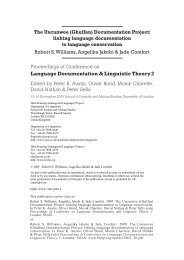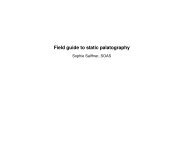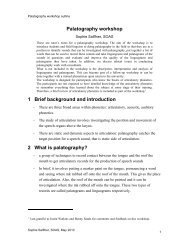Language Documentation & Linguistic Theory 2 - Hans Rausing ...
Language Documentation & Linguistic Theory 2 - Hans Rausing ...
Language Documentation & Linguistic Theory 2 - Hans Rausing ...
You also want an ePaper? Increase the reach of your titles
YUMPU automatically turns print PDFs into web optimized ePapers that Google loves.
Gender and person markers in Cicipu discourse: ‘non-topical’and ‘topical’ anaphoric agreement 1STUART MCGILLSchool of Oriental and African Studies1. INTRODUCTIONOver the last few decades linguists have made considerable progress in theirunderstanding of agreement markers/incorporated pronouns. One of the mostimportant theoretical contributions has been Bresnan and Mchombo‘s (1987)distinction between grammatical agreement and anaphoric agreement, and theassociation of the latter with topical referents. This association between anaphoricagreement and topicality has largely gone unchallenged, and is frequentlyrepeated in the typological literature. The aim of this paper is to present data fromthe agreement system of Cicipu (Kainji, Nigeria) which shows that topicality isnot necessarily derivative of the distinction between grammatical and anaphoricagreement, but is instead an independent dimension along which anaphoricagreement markers can be classified.The paper is structured as follows: section 2 questions the assumption thatanaphoric agreement markers must always have topical referents; section 3 thenintroduces the two paradigms of agreement in Cicipu, gender and person; whilesection 4 considers their distribution across a corpus of approximately 12,000clauses. We find that both gender and person markers may take part ingrammatical and anaphoric subject agreement, with the person markers associatedwith referents that are discourse-topical and/or animate.2. AGREEMENT MARKERS AND TOPICALITYFor languages with optional agreement, the presence of agreement morphology isoften correlated with the topicality of the controller referent. 2 A well-known caseis object agreement in the Bantu languages. Bresnan and Mchombo (1987)describe the asymmetries between (obligatory) subject and (optional) objectagreement in the Bantu language Chicheŵa, and provide an analysis framed inLexical-Functional Grammar (LFG). They make the distinction betweenGRAMMATICAL AGREEMENT, where the agreement marker is a redundant affixexpressing the gender of a co-occurring subject NP (e.g. (1a) for a Cicipuexample), and ANAPHORIC AGREEMENT, in which case the agreement marker is an1 This paper is based on my PhD thesis, submitted to the School of Oriental and African Studies.2The controller is the constituent (usually an NP) ‘controlling’ the agreement morphologydisplayed on the agreement ‘target’ (Corbett 2006).221
STUART MCGILL(2) While our niece and her young suitor wandered around the store, shereached into a bin of m&ms and snagged her finger on something.Whatever it was, it cut her.Her suitor, wishing to be a gentleman, expressed concern, but also toldher he didn’t like blood. She tried to shield her finger from him, but whenthe depth of her wound finally freaked her out a little, she showed it tohim. The boy fell. Hard. Onto his face. 5The highlighted unstressed pronouns take this form not because the discourse is‘about’ the offending object, but simply because it has just been mentioned.Siewierska’s ‘highly cognitively accessible’ and ‘topical’ are not the same thing, afairly trivial point but one often missed in the literature on agreement. WhileEnglish may use a single coding technique (unstressed pronouns) for both topicalreferents and non-topical highly-accessible referents, this is not true in general, asthe Cicipu data in section 4 will show.Culy (2000) takes the opposite view to Siewierska, and suggests that crosslinguistically,incorporated pronouns may index sentence topics, discourse topics,or non-topical referents. Thus he regards topicality as an independent dimensionalong which agreement markers can be classified, rather than one derivative of thegrammatical vs. anaphoric agreement distinction.Culy’s typology is a little suspect since it relies on work by scholars using verydifferent methodologies to his own. LFG researchers often depend onintrospection/elicitation for their insights, whereas Culy worked with texts fromthe extinct language Takelma. The former typically follow Lambrecht’s (1994)theory of SENTENCE TOPIC, which is concerned with the pragmatic presuppositionsof speakers at a snapshot during a discourse, and how these affect the structure ofa single clause or sentence. Culy’s conception of topic, however, is more in linewith DISCOURSE TOPIC (e.g. Chafe 1994, Dooley 2007), which is concerned withhow topics are established and maintained throughout a paragraph or even awhole text. Another difficulty is that he compares markers across differentlanguages – this is not surprising, since according to Siewierska (2004: 67):…there do not appear to be distinct dependent markers solely fordifferent information statuses of their referents within the discourse.This follows largely from the fact that languages tend to have only onetype of dependent person marker for a given syntactic function.Cicipu does have two series of dependent person markers for the same function,and this makes it a good test case to determine whether dependent markers can infact vary with respect to their discourse function. As we will see in section 4, theCicipu data supports Culy’s basic contention that topicality should be regarded asan independent dimension for the classification of agreement markers. In the case5 Taken from a blog entry at http://sonmislocuras.com/page/2/.223
LANGUAGE DOCUMENTATION AND LINGUISTIC THEORY 2of Cicipu it is discourse topic rather than sentence topic which allows us todistinguish between the two paradigms of Cicipu agreement markers.3. CICIPU GENDER AND PERSON PARADIGMSLike all Benue-Congo languages, nouns in Cicipu can be divided into classesaccording to the prefixes found on the singular and plural. For example, kà-ràkúmí/à-ràkúmí ‘camel/camels’ belongs to the KA class in the singular and the A class inthe plural. Similarly mà-wáa /ǹ-wáa ‘dog/dogs’ belongs to the MA class in thesingular and the N class in the plural. Noun class or GENDER agreement is found ona great many agreement targets inside and outside the noun phrase. Example (3)shows agreement on a demonstrative modifier, the relativiser, and verbs.(3) (a) ká-llù ké-llè ká-nà kà-yâa-nàNC1-hunger AG1-that AG1-REL AG1-arrive\RLS-PFV‘that hunger which arrived’(b) mà-wáa mé-llè má-nà mà-sí-hùnàNC4-dog AG4-that AG4-REL AG4-HAB-kill‘that dog which kills’Where Cicipu differs from the more well-known Bantu languages is that for anumber of these targets, gender agreement is in competition with a separateparadigm, that of PERSON agreement. Example (4a) shows AG1 gender agreementon the verb, while (4b) shows gender-neutral 3PS person agreement.(4) (a) kò-dôohò (b) ù-dôohòAG1-disappear\RLS3S-disappear\RLS‘it disappeared’‘it disappeared’Since gender is not marked for first and second persons, the alternation isconfined to the third person. The alternation also exists for plural nouns. (5a)shows gender agreement while (5b) shows (gender-neutral) person agreement:(5) (a) hò-dôohò (b) ò-dôohòAG2-disappear\RLS 3P-disappear\RLS‘they disappeared’‘they disappeared’Although this paper concentrates on subject agreement prefixes, the samealternation is also found on pronouns, the article, the interrogative quantifier -èné‘which’, demonstrative pronouns and modifiers, and the copula. 6 Thus there is aseries of competing paradigms across different agreement targets.6 There is no object agreement in Cicipu.224
STUART MCGILLIt remains to set out the paradigms themselves. There are nine syntactic nounclasses in Cicipu, the agreement prefixes of which are as follows: 7Table 6Cicipu gender agreement prefixesClass 1 2 3 4 5 6 7 8 9Prefix ka- ha- yi- ma- mi- ti- wu- Ø-/vi- ku-The person system is the common six-way distinction involving person andnumber:Table 7Cicipu person agreement prefixesSingular Plural1 m- ti-2 Ø-/v- i-3 u- a-In principle, every Cicipu noun has the possibility of triggering either genderagreement or person agreement. In the following section I turn to the factorsinfluencing which paradigm of prefixes will in fact occur.4. FACTORS RELEVANT FOR THE GENDER/PERSON ALTERNATION4.1. Other Kainji languagesThe gender/person alternation found in Cicipu is also present in other Kainjilanguages, as well as the related Platoid branch of Niger-Congo. Hoffman drewattention to the alternation in Central Kambari (Kainji), calling it ‘a very peculiarfeature’ (1963: 168). For him DEFINITENESS was the key to the alternation;indefinite subject NPs trigger gender agreement, whereas definite subjects triggerperson agreement.According to Crozier (1984: 215-222), although Hoffmann’s analysis worksmost of the time, definite subjects in Central Kambari do sometimes triggergender agreement. The determining factor according to Crozier is the TOPICALITYof the subject referent. If the subject is topical, then it will trigger personagreement, otherwise it will trigger gender agreement. Crozier’s account is closerto what we are about to find for Cicipu, but it does not provide the whole story.7 Cicipu has ten noun class prefixes, but two of these share the same agreements, and so we cansay that there are ten morphological noun classes but only nine syntactic noun classes. Singularand plural noun classes pair up in different ways to make seven paired genders and nine singleclass genders. See McGill (2007) for details.225
LANGUAGE DOCUMENTATION AND LINGUISTIC THEORY 24.2. Cicipu agreement prerequisitesFor cases of variation in agreement, Corbett (2006) uses the term CONDITIONS torefer to the factors that determine which of the available agreement patternsoccurs. He is careful to distinguish between conditions and PREREQUISITES:The essential difference is that prerequisites specify what is necessaryfor agreement... while conditions affect the use of an agreement formwhere the prerequisites are met. (Corbett 2006: 183)The factors involved in Cicipu are complex and it is helpful to separate them outinto prerequisites and conditions, with the latter only coming into play inenvironments where there is a choice between gender and person agreement.The most obvious prerequisite concerns the subject NP. If there is an explicitsubject NP (i.e. grammatical rather than anaphoric agreement), then usually thereis no choice, and the features indexed on the verb are a straightforward copy ofthe features on the NP. In the grammatically correct examples (6a, 7a) the featureson the subject and verb match – gender in (6a) and person in (7a). Where thefeatures do not match, as in (6b) and (7b), the sentences are ungrammatical. Thisis the case even if the antecedent of èvì in (7b) is an NC1 noun such as kà-ràkúmí‘camel’.(6) (a) kà-ràkúmí kò-dôohò (b) *kà-ràkúmí ù-dôohòNC1-camel AG1-disappear\RLS NC1-camel 3S-disappear\RLS‘the camel disappeared’(7) (a) èvì ù-dôohò (b) *èvì kò-dôohò3S.PRO 3S-disappear\RLS 3S.PRO AG1-disappear\RLS‘it disappeared’Subjects lacking a specification for gender (such as personal pronouns, personaldemonstrative pronouns, and the names of people) may only co-occur with personsubject agreement, not gender subject agreement. As with (7b), (8b) would beungrammatical even if the antecedent of é-mpè was an NC1 noun.(8) (a) é-mpè ù-dôohò (b) *é-mpè kò-dôohò3S-this 3S-disappear\RLS 3S-this AG1-disappear\RLS‘this one disappeared’There is one scenario in which person agreement is possible with a gender-markedsubject NP – if the subject NP is NC8, and the verb stem is vowel-initial – but onlyif the referent is sufficiently animate or discourse-topical. Example (9) illustratesthe choice for an inanimate referent; (9b) is only possible if the Koran is adiscourse topic.226
STUART MCGILL(9) (a) Ø-kùrì'áanì v-ú-'ɔ̀pɔ̀ z-záNC8-Koran AG8-FUT-hold\IRR NC8-person‘the Koran will take hold of someone’(b) Ø-kùrì'áanì w-ú-ɔ̀pɔ̀ z-záNC8-Koran 3S-FUT-hold\IRR NC8-person‘the Koran will take hold of someone’In summary, person agreement is possible if one of the following threeprerequisites is met: (i) there is no subject NP, (ii) there is a subject NP but it isunspecified for gender, (iii) there is an NC8 subject NP and the verb stem isvowel-initial. Otherwise, only gender agreement can occur.4.3. Cicipu agreement conditionsAgreement conditions apply when more than one possibility for agreement exists.In order to determine the relevant conditions for Cicipu I examined thedistribution of the two different types of agreement over a multi-genre interlinearcorpus of 12,000 clauses. This consists partly of texts collected through a projectfunded by the <strong>Hans</strong> <strong>Rausing</strong> Endangered <strong>Language</strong>s <strong>Documentation</strong> Programme,and partly of texts collected specifically to investigate this alternation. Aqualitative analysis of subject agreement in these texts reveals that animacy anddiscourse topicality are two independent conditions influencing the alternationbetween gender and person agreement, in those environments where both canoccur.4.3.1. Inanimate referentsReferents which are both inanimate and non-topical rarely function as the subjectsof clauses. On occasion, however, anaphoric chains of inanimate non-topicalsubject referents do occur, in which case they are without exception coded usinggender agreement. Inanimate topical referents may trigger person agreement,although they do so rarely. Examples of inanimate referents triggering personagreement include beer, gin, tobacco, the Bible, the Koran, palm-wine, fishtrapping, trees, a lake, a fence, and clothing. In each case the referent is adiscourse topic.4.3.2. AnimalsNon-topical animal referents are without fail encoded using gender agreement. Incontrast, topical animals are very often indexed using person agreement, and infact the corpus does not contain any examples of topical animal referents whichfail to progress from gender-marking to person-marking. Thus animals clearlyreflect the importance of topicality. The following two examples, from separatetexts, form a ‘minimal pair’. The first example (10) is from a text about monkeys,the second (11) from one about dogs. Common to both texts is that they include asection about a dog chasing another animal: the monkey in the first instance, and ahare in the second. The crucial difference is that the dog is not a discourse topic in227
LANGUAGE DOCUMENTATION AND LINGUISTIC THEORY 2the first excerpt, but it is in the second. Observe the contrasting means by whichthe dog is referred to in each of the examples 8 :(10) ǹ w-ǐndà mà-wáa mò-wṍsõ̀ / hálì m-ǔuwà kù-sṹuand 3S-see\RLS NC4-dog AG4-bark\RLS even AG4-feel\RLS NC9-smellkwéevì mò'úngònò mɔ̀dɔńìvì nìiláɗí /kw-éevì mò-'úngò-nò mɔ̀-dɔńɔ̀=vì n=ì-láɗí /AG9-3S.POSS AG4-rise\RLS-VENT AG4-follow\RLS=3S.PRO and=NC3-speed‘if it sees the dog bark / it feels its smell it gets up and it follows it fast’tò, n=ù-súmà / ù-náhà ù-gítà-nà mázámázáOK and=3S-run\RLS 3S-leave\RLS NC7-return-VENT hurriedly‘OK, when it runs / it won’t come back in a hurry’(11) tò, lóokàcí wú-nà mà-wáa, ǹ mɔ̀-dɔńɔ̀ mà-díyá /OK time 3S- NC4-dog and AG4-follow\RLS NC4-hareARTn=ù-húnà mà-díyá á↓=ká-dábá /and=3S-kill\RLS NC4-hare LOC=NC1-bush‘OK, some dogs [lit. ‘a certain dog’], when it follows a hare / when it killsa hare in the bush /’ù-sì-ràa cé 'ũ̂ / ù-sì-ràa cé /3S-HAB-eat NEG there 3S-HAB-eat NEGsée ú-tòonò ǹ m-é /unless 3S-come back home\IRR with AG4-PRO‘it doesn’t eat [it] there/ it doesn’t eat [it] / then it comes back homewith it /’In (10) the non-topical dog is indexed by subject gender agreement (mA-), whilethe topical monkey is indexed with person agreement (in a variety ofmorphosyntactic positions). In (11) the topical dog is at first marked with genderagreement, but then it graduates to person agreement. This is an instance of ageneral property of discourse-topical referents, i.e. they undergo a codingprogression from LEXICAL NP > GENDER AGREEMENT > PERSON AGREEMENT. Thehare, on the other hand, is only marked with gender agreement. It is important tonote that the propositions encoded in several of the individual clauses in (10) areabout the dog, and so the dog qualifies as a sentence topic 9 . However the dog in8 Bold references are to the dog, underlined references are to the monkey and the hare.9 See Lambrecht (1994: 149) for analysis of a similar example.228
STUART MCGILL(10) is not of intrinsic interest (Dooley 2007) to the speaker, instead its role is totell us something about the monkey. It is only by considering the role of theparticipants in the wider discourse (i.e. discourse topicality) that the differences inmorphosyntactic coding seen in (10) and (11) can be accounted for.The third intonation unit in (10) (beginning n=ù-súmà) provides an interestingparallel to the second intonation unit in (11) (beginning n=ù-húnà). In both casesthe previous clause encoded the dog as subject by means of anaphoric genderagreement. In (11) the subject remains the same going into the second intonationunit, seamlessly transitioning from gender agreement to person agreement.However in (10), the subject of the verb ù-súmà is now the monkey, no longer thedog. Note that apart from the association of person agreement with topic that I amarguing for here, everything else points to topic continuity. The subject isexpressed using minimal coding and there is no discontinuity of action: the dog isfollowing the monkey with speed in one clause, and then something is running offin the next and neglecting to come back. Had the speaker been making a point thatdogs often disappeared off on their own while chasing monkeys, then no doubtthis sentence could have been used with the dog remaining as the subject referent.However because the hearer understands that in (10) the monkey and not the dogis topical, the speaker can use the 3PS marker u- without fear of ambiguity. Sinceanimal referents can only be encoded using person agreement if they arediscourse-topical, u- can only refer to the monkey in this text.This pair of examples also brings home the fact that discourse topicality isabout more than just referential density. In (10) four references to the dog aremade in the space of two intonation units, but it nowhere triggers personagreement. Simply talking about a referent is not enough to make it a discoursetopic. Instead, it is the speaker’s intrinsic interest that elevates frequentlymentionedreferents to the status of discourse topic, and, as far as non-humanreferents in Cicipu are concerned, allows them to graduate from anaphoric genderagreement to anaphoric person agreement.4.3.3. HumansIt does not follow that all human referents encoded in a text are discourse topics.Humans can be of trivial importance in a text, despite their inherent topicality. If areferent fails to persist and therefore does not integrate the discourse schema for atext, or if the interlocutors have no intrinsic interest in that referent, then it cannotbe said to be a discourse topic. So we might expect to find some examples of nontopicalhuman referents in the corpus, and thus it is a non-trivial question as towhether they will be marked with gender or person agreement. Briefly, the answeris that human referents in the corpus are usually marked with person agreement,but gender agreement is likely to persist longer (i.e. across intonation units) fornon-topical referents.229
LANGUAGE DOCUMENTATION AND LINGUISTIC THEORY 25. CONCLUSIONWe have seen that there are two paradigms of agreement morphology in Cicipu,one inflected for gender and the other for person, and in section 4 I set out thefactors relevant to this alternation with regard to subject agreement. Wheneverthere is an explicit subject NP (i.e. grammatical agreement) the features on theverb must match the features on the subject NP. 10 When there is no subject NP(i.e. anaphoric agreement) either gender or person agreement may occur.Anaphoric chains can progress from LEXICAL NP > GENDER AGREEMENT >PERSON AGREEMENT. This happens more quickly if the referent is high intopicality and/or animacy, and the effect of topicality is particularly clear withanimals.Anaphoric agreement markers occur with both topics and non-topics in Cicipu.Therefore topicality should be considered an independently-varying dimensonwith respect to the classification of agreement markers, not one determined by thegrammatical vs. anaphoric agreement distinction, and thus it is possible to havedistinct dependent markers encoding different information statuses (contraSiewierska 2004).Finally, neither sentence topic nor referential density are sufficient to accountfor the examples in section 4. Instead we need a theory of discourse topic that alsotakes into account the intrinsic interest which the referent holds for the speaker.Unlike generativists, most typologists hold that linguistics should be grounded inempirical data. Consequently typological claims about the nature of agreementand incorporated pronouns should take into account the possibility of grammaticalstructure being influenced by discourse topic as well as sentence topic.REFERENCESBresnan, Joan & Sam A. Mchombo. 1987. Topic, pronoun, and agreement inChichewâ. <strong>Language</strong> 63, 741-82.Chafe, Wallace. 1994. Discourse, consciousness, and time. Chicago: University ofChicago Press.Corbett, Greville G. 2003. Agreement: the range of the phenomenon and theprinciples of the Surrey Database of Agreement. Transactions of thePhilological Society 101, 155-202.Corbett, Greville G. 2006. Agreement. Cambridge: Cambridge University Press.Crozier, David. H. 1984. A study in the discourse grammar of Cishiningi. PhDdissertation, University of Ibadan.10 The exception to this being the co-occurrence of an NC8 controller and a vowel-initial verb, asmentioned in section 4.2.230
STUART MCGILLCuly, Christopher. 2000. An incorporated topic marker in Takelma. In MiriamButt & Tracy Holloway King (eds.), Proceedings of the LFG 00Conference, University of California, Berkeley, 63-81. Stanford: CSLIPublications.Dooley, Robert A. 2007. Explorations in discourse topicality. SIL ElectronicWorking Papers. http://www.sil.org/silewp/2007/silewp2007-010.pdf (1stSeptember 2009).Hoffmann, Carl. 1963. The noun-class system of Central Kambari. Journal ofAfrican <strong>Language</strong>s 2(2), 160-169.Lambrecht, Knud. 1994. Information structure and sentence form. Cambridge:Cambridge University Press.McGill, Stuart. 2007. The Cicipu noun class system. Journal of West African<strong>Language</strong>s 34(2), 51-90.Siewierska, Anna. 2004. Person. Cambridge: Cambridge University Press.231


